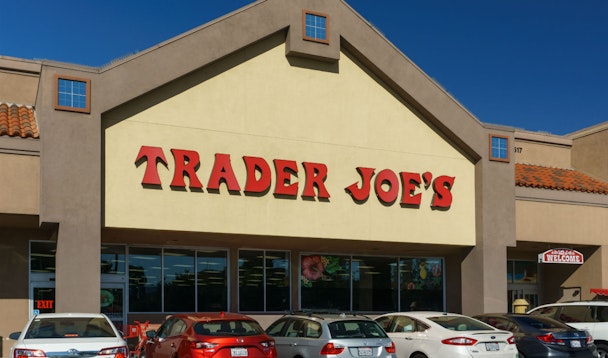What can Trader Joe’s teach the ad industry? A lot.
Trader Joe’s is a $10bn supermarket chain that doesn’t have an agency of record. What it does have is a cult of devoted fans that any brand would covet. Its success is a reminder that the best advertising in the world will land flat if a company’s customer experience doesn’t back up its brand promise.

I’ve seen this firsthand.
After 20 years in the advertising industry, I took a $12-an-hour job as a Trader Joe’s crew member. I wrote "Build a Brand Like Trader Joe’s" to explain how the company built one of America’s strongest brands without the expense of an ad agency, PR firm, or design house; to this day it maintains only a rudimentary presence on social media.
So, what can you learn from Trader Joe’s? That it might be time to launch a whole new line of business — and, no, I don’t mean you should sell groceries.
Trader Joe’s turn rates and sales per square foot are double its nearest rival and customer surveys frequently rate it as America’s favorite grocery store. It’s built a devoted cult of fans on the strength of a unique corporate culture.
You can’t build a brand like that on a single trait. Trader Joe’s limited selection of mostly own-brand products, quirky packaging and newsletter (produced in-house), hand-painted in-store signage, and casual uniforms all contribute. But Trader Joe’s hiring practices, training, and internal documents all prove that the brand is anchored in the stores’ unique customer-service ethos. I confirmed that by direct observation during my year behind the scenes.
Those famously friendly cashiers are not there by coincidence. Crew members are hired for their naturally extroverted, empathetic personalities. Training is almost entirely focused on customer interaction.
Have you ever come upon a Trader Joe’s crew member, restocking shelves at peak time, creating a traffic jam of customers and carts in the aisle? Managers juggle schedules to maximize random encounters between staff and customers, and rate crew members on their ability to strike up conversations.
Even as a new crew member (the lowest-level employee) I was empowered to do almost anything for a customer. Spend 15 minutes in the storeroom looking for a $5 item at a customer’s request? No problem. If I encountered a customer who seemed to be having a bad day, I could give her a bouquet of flowers on my own initiative. Any time a customer asked, “What are these like?” I could open a package and give them a free sample.
The Trader Joe’s brand is built on millions of face-to-face encounters like those. And the chain pays better-than-average salaries to get its pick of cheerful extroverts, who are happy to run with the vague order to “go out there and be friendly.” At a time when America is experiencing an epidemic of loneliness, Trader Joe’s brand-building strategy works better than ever.
That new line of business
After my long career as an ad creative, I was dismayed to realize that Trader Joe’s built a wildly profitable cult brand by skipping almost every step that I’d told my clients was essential.
The secret of Trader Joe’s success is not limited to the grocery category. Best Buy, Zappos, and AppleCare prove that friendly and empowered customer service builds brand equity. It doesn’t matter whether your clients sell goods or services, or whether they operate from brick-and-mortar stores or online.
Trader Joe’s secret sauce — customer experience (CX) — works on customers of all ages. Kibitzing with customers while I bagged their bananas, I came to this realization: ad and branding agencies are committing a gross strategic error by leaving the most important part of CX to clients.
Shaping the customer experience could present you with a new and potentially profitable service to offer clients. But it also provides another important benefit: preserving the value of all the other work you do.
You can come up with a great name and logo for a client, create a buzzworthy social campaign that drives web traffic, craft a great omnichannel campaign that piques interest, and finally geo-target customers at precisely the right time and place. But all that work is wasted if prospective customers come face-to-face with an employee who is bored, frustrated by rules and procedures, or couldn’t care less.
The best first impression will always be undone by the worst last impression. In fact, by raising the customer’s expectations with your great branding work, you make their disappointment worse when the experience is poor. Adding injury to that insult, your client may well blame youwhen that precious new customer leaves without buying, and never returns.
Ad and branding agencies have always claimed to be experts on what consumers want and expect, what motivates them, and how they behave. And yet after shaping almost every other aspect of the brand, we leave clients on their own at the most important moment: the sale.
It’s time to go the last mile by coaching our clients – and their frontline service and sales personnel – to leave a great last impression.
Empowering frontline staff is a scary proposition. Your client’s brand equity may be their single biggest asset. You’ll be asking them to take that asset out of the hands of the CMO – one of their highest-paid executives – and put it in the hands of staff who are probably their lowest-paid employees.
But think of it this way: that low-paid staff has always been empowered to reduce brand equity. Why not encourage them to increase it?
Mark Gardiner is chief executive officer of RevolutionaryOldIdea.com and author of “Build a Brand Like Trader Joe’s”

